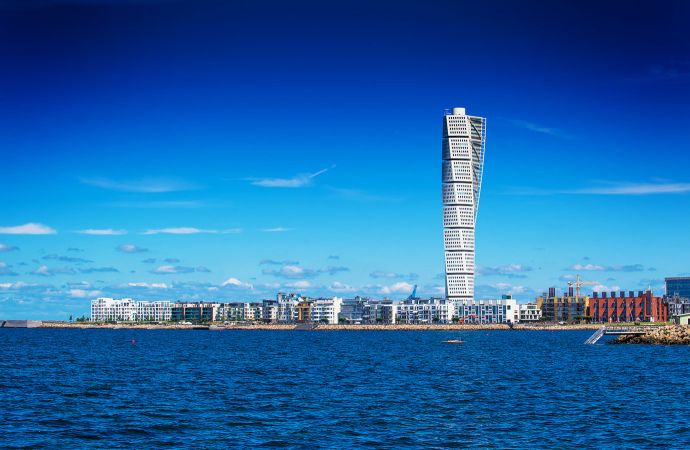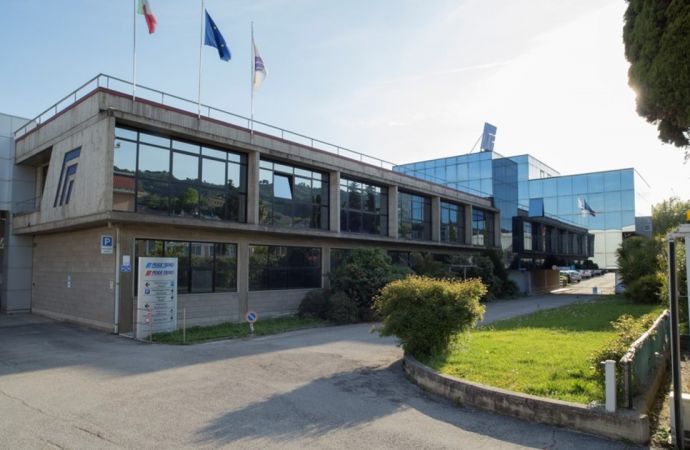Four GEA ammonia heat pumps, each with a heating capacity of 10 MW (in total 40 MW), have been installed at an E.ON-operated district heating plant. Accelerate Europe reports.

Malmö's harbour area.
E.ON, one of the world's largest investor-owned electric utility service providers, last year (December 2017) completed a 40 MW ammonia heat pump project for district heating in the harbour area of the city of Malmö, Sweden.
Four GEA ammonia heat pumps, each with a heating capacity of 10 MW, use the heat from Malmö’s sewage treatment and waste incineration plants to deliver heating to approximately 100,000 homes in the Swedish city.
“We started in 2015 and then we got our investment decision in May 2016. We signed the contract in July with Francks Kylindustri [a Swedish contractor specialised in cooling and heating with ammonia],” Mats Egard, E.ON Sweden’s heating segment project manager, told Accelerate Europe.
The heat pumps take advantage of the waste heat from the sewage and waste plants, in the harbour area, to provide heating to approximately 100,000 homes in greater Malmö. Installing the four GEA heat pumps took approximately 14-15 months. Groundwork began in August-September 2016, “and we commissioned the last heat pump at the end of December 2017,” says E.ON’s Egard.
E.ON decided to use the sewage water to provide base heat for the heat pump due to the higher temperature emitted by the sewage plant (14°C) – making the water warmer than the sea near Malmö. “In January and February, sometimes the seawater even goes below zero, and then it’s impossible to get any heat out of it. That's when the heat is at its most valuable – when it’s colder outside,” Egard says.
“The sea outside Malmö is too shallow. If you have deeper seas, you always have 4°C at the bottom of the sea, but you don't have that here,” he says.
Kenneth Hoffmann, GEA’s product manager for heat pumps, was also involved in the Malmö project. “They have [seawater heat pumps] a lot in Norway with the deep fjords, but then you can get down to the bottom of the sea, which is perhaps 20-30 metres deep – you have a constant temperature down there of 8°C,” Hoffmann says.
The four heat pumps withdraw 30 MW of heat from the sewage water. “On average the wastewater is chilled from 14°C to 8°C,” writes Hoffmann in an Institute of Refrigeration (IOR) paper on ‘Large-scale heat pumps for high efficiency district heating projects’. “The energy harvested is upgraded to useful heat for the district heating network through the heat pumps,” he adds.
The heat pump has been integrated with the district heating network to work in conjunction with the nearby waste incinerator plant. “The water from the city returns to the waste incinerator plant at around 50°C, where in the flue gas economiser it is heated to around 55°C” before going into the heat pump at 66°C, Hoffmann explains in the paper.
For each 1 kWh of electricity used by the heat pump, 3.5 kWh of heat is produced for the city."
– Kenneth Hoffmann, GEA’s product manager for heat pumps
“The water then returns to the waste incinerator plant where it is […] heated to the requested temperature by the heating network, which can vary depending on the heating demand from 70°C to 90°C. The heat pump is designed for delivering heat up to 80°C, but will rarely deliver temperatures above 71°C,” the paper says.
The four heat pumps work in parallel to deliver the promised temperatures. Each has a coefficient of performance (COP) above 3.50, “so for each 1 kWh of electricity used by the heat pump, 3.5 kWh of heat is produced for the city,” says GEA’s Hoffmann.
The heat pumps, then, are certainly helping E.ON to deliver on its sustainability commitments.
For more on this story please check out the latest edition of Accelerate Europe.
Related stories



_1522327086.png)
